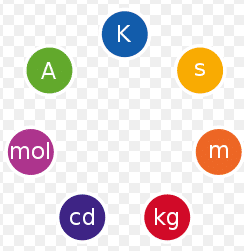What is The International System of Units?
 In 1960, an international committee agreed on a set of definitions and standards to describe the physical quantities. The system that was established is called the international system of units (SI).
In 1960, an international committee agreed on a set of definitions and standards to describe the physical quantities. The system that was established is called the international system of units (SI).
The SI system is formed from three types of units:
- Base units
- Derived Units
- Supplementary units
Base units:
There are seven base units for different physical quantities, such as length, mass, time, temperature, electric current, luminous intensity, and amount of substance.
| No | Physical quantity | Symbol of quantity | SI unit | Symbol of unit |
| 1 | Length | L | meter | |
| 2 | Mass | M | kilogram | |
| 3 | Time | T | second | |
| 4 | Electric current | I | ampere | |
| 5 | Temperature | T | kelvin | |
| 6 | Light intensity | L | candela | |
| 7 | Amount of substance | n | mole |
Supplementary units:
The units which are neither base units nor derived units are called supplementary units and are often used for geometrical quantities. They are:
- Plane angle
- The solid angle
Standard definitions of supplementary units
- Radian
It is the angle subtended between two radii and arc of a circle whose length is equal to the radius of the circle.
- Steradian
It is the solid angle (three-dimensional angle) subtended at the center of the sphere by an area of surface equal to square the radius of the sphere.
| Physical quantity | SI unit | Symbol |
| Plane angle | Radian | rad |
| Solid angle | Steradian | sr |
Derived Units:
The SI units for measuring all other physical quantities are derived from the base and supplementary units, such units are called derived units.
| Physical quantity | Unit | Symbol | In terms of base units |
| Force | Newton | N | Kg ms-2 |
| Work | Joule | J | Nm = kg m2s-2 |
| Power | Watt | W | Js-1 |
| Pressure | pascal | pa | Nm-2 |
Convection’s for indicating the Units
Use of SI units require special care, more particularly in writing prefixes:
- The full name of the unit does not being with a capital letter even if named after scientists e.g., newton, pascal, ampere.
- The symbol of units after a scientist has initial capital such as N for newton.
- The prefix should be written before the unit without any space, such as 1 mm, 1nm.
- A combination of base units is written each with one space apart.
For example, the newton meter is written as Nm.
- Compound prefixes are not allowed.
- When a multiple of the base unit is raised to a power, the power applies to the whole multiple and not the base unit
- Measurement in practical work should be recorded immediately in the most convenient unit e.g, micrometer screw gauges measurement in mm, and the mass of calorimeter in grams. But before calculation for the result , all measurements must be converted to the appropriated SI base unit.
Brows Also:
- Types of physical quantities
- Difference between scientific notation and significant figures
- Types of errors in measurement
- Difference between accuracy and precision
- Dimensional analysis in physics
- Vernier caliper least count formula
- Screw Gauge least count formula
- Difference between screw gauge and vernier caliper
Great Explain! SI Units or International System of Units.